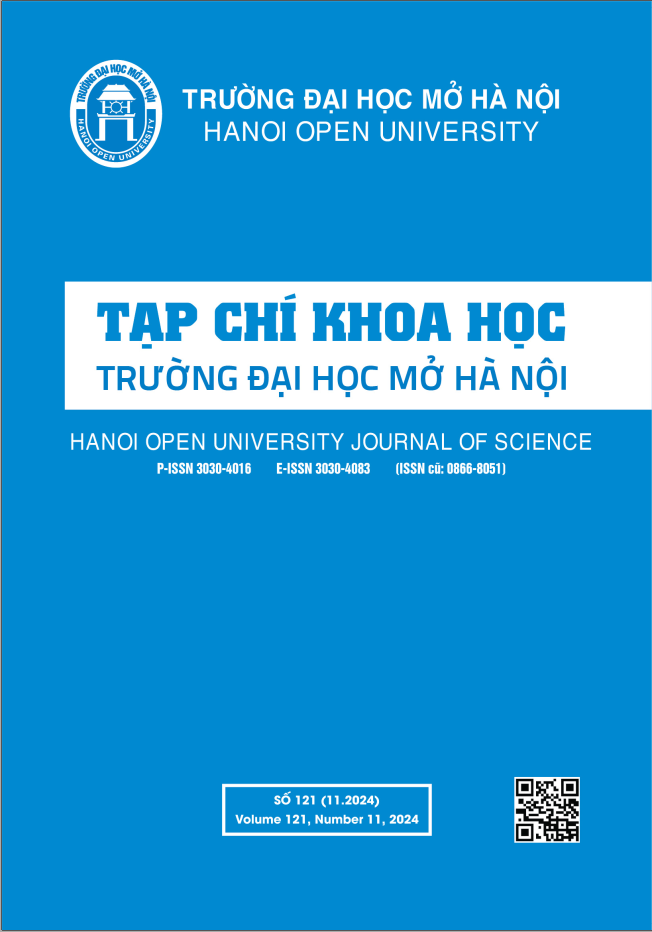CÁC YẾU TỐ ẢNH HƯỞNG ĐẾN VIỆC ỨNG DỤNG CÔNG NGHỆ VÀO GIẢNG DẠY TIẾNG ANH EFL TẠI VIỆT NAM: MỘT NGHIÊN CỨU ĐIỂN HÌNH
DOI:
https://doi.org/10.59266/houjs.2024.489Keywords:
tích hợp công nghệ, độ tuổi, trình độ công nghệ và nhận thức của giảng viên EFLAbstract
Sự phát triển nhanh chóng của công nghệ thông tin trong dạy và học ngoại ngữ đã trở thành một xu hướng và nhu cầu thiết yếu (M. R. Ahmadi, 2018). Có nhiều yếu tố ảnh hưởng đến việc tích hợp các công nghệ mới vào lớp học tiếng anh như một ngoại ngữ [English as a Foreign Language –(EFL)]. Trong nghiên cứu (NC) này, Nhà nghiên cứu (NNC) tập trung vào khảo sát các yếu tố về độ tuổi, trình độ CNTT và nhận thức của giáng viên. NNC đã sử dụng bảng câu hỏi gồm 21 câu hỏi với sự tham gia của 30 giảng viên EFL tại khoa Ngoại Ngữ, Đại học Kinh tế- Kỹ Thuật Công nghiệp (UNETI). Kết quả cho thấy sự khác nhau về độ tuổi của giảng viên trong tích hợp CNTT không có hạn chế nào đáng kể. Tuy nhiên, điều đáng bàn là cả trình độ và nhận thức của giáng viên về CNTT có sự khác biệt rõ rệt khi ứng dụng tích hợp CNTT trong lớp học EFL tại UNETI. Nhà trường cần có chính sách khích lệ giảng viên tập trung vào bồi dưỡng và phát triển chuyên môn và hỗ trợ họ về tích hợp CNTT, bên cạnh đó cũng nên cung cấp cho lớp học thiết bị hỗ trợ học tập như máy tính và bảng thông minh giúp sinh viên tiếp cận CNTT tân tiến, để quá trình học của các em có nhiều thuận lợi.
References
[1]. Ahmadi, D., & Reza, M. (2018). The use of technology in English language learning: A literature review. International Journal of Research in English Education, 3(2), 115-125. https://doi.org/10.29252/ijree.3.2.115
[2]. Al-Asmari, A. M. (2005). The use of the Internet among EFL teachers at the colleges of technology in Saudi Arabia (Doctoral dissertation, The Ohio State University).
[3]. Aydin, S. (2013). Teachers’ perceptions about the use of computers in EFL teaching and learning: the case of Turkey. Computer Assisted Language Learning, 26(3), 214-233.
[4]. Dörnyei, Z. (2007). Research methods in applied linguistics: Quantitative, qualitative, and mixed methodologies (pp. 95-123). Oxford: Oxford University Press.
[5]. Hastings, T. A. (2009). Factors that predict quality classroom technology use (Doctoral dissertation, Bowling Green State University).
[6]. Henry, A. M. (2008). The relationship of age, gender, and personality style with the level of technology implementation at the university level. Walden University.
[7]. Jones, A. (2004). A review of the research literature on barriers to the uptake of ICT by teachers.
[8]. Mahdi, H. S., & Al-Dera, A. S. A. (2013). The Impact of Teachers’ Age, Gender and Experience on the Use of Information and Communication Technology in EFL
[9]. Mollaei, F., & Riasati, M. J. (2013). Teachers’ perceptions of using technology in teaching EFL. International Journal of Applied Linguistics and English Literature, 2(1), 13-22. https://doi.org/10.7575/ ijalel.v.2n.1p.13
[10]. M.R. Ahmadi, “The use of technology in English language learning: a literature review”, International Journal of Research in English Education, Vol. 3, no. 2, pp. 115-125, 2018. https://doi. org/10.29252/ijree.3.2.115.
[11]. Pallant, J. (2013). SPSS survival manual. McGraw-Hill Education (UK).
[12]. Pourhosein Gilakjani, A., & Sabouri, N.B. (2014). Role of Iranian EFL teachers about using Pronunciation Power Software in the instruction of English pronunciation. English Language Teaching, 7(1), 139-148. https://doi. org/10.5539/elt.v7n1p139
[13]. Saqlain, N., & Mahmood, Z. (2013). English Language Instructors’ Perceptions about Technology-Based Language Learning at Northern Border University in Saudi Arabia. Turkish Online Journal of Educational Technology-TOJET, 12(2), 106-110.
[14]. The Centre for the Study of Learning and Performance (CSLP). Technology Implementation Questionnaire: Version II. (n.d.) Retrieved from https://www. concordia.ca/content/dam/artsci/ research/cslp/docs/TIQ2.pdf
[15]. Zhao, Y., Pugh, K., Sheldon, S., & Byers, J. L. (2002). Conditions for classroom technology innovations. Teachers’ college record, 104(3), 482-515. https:// doi.org/10.1111/1467-9620.00170
